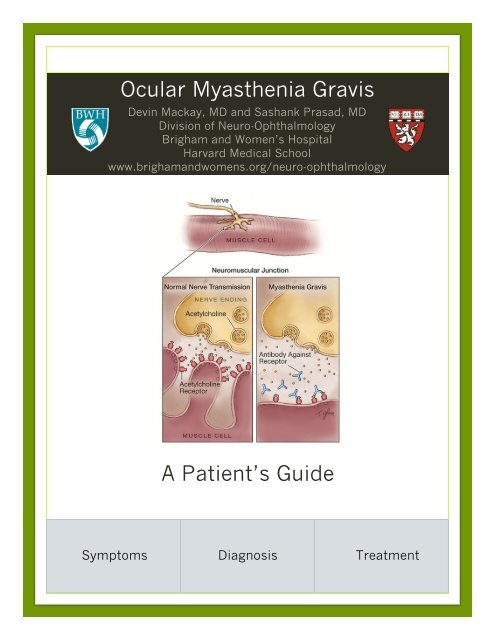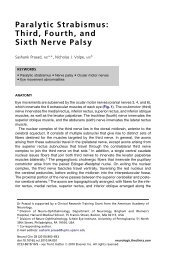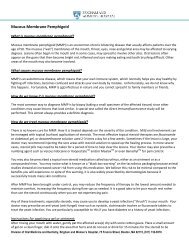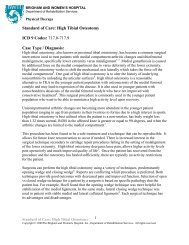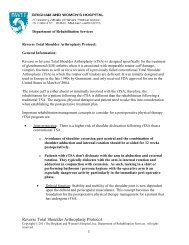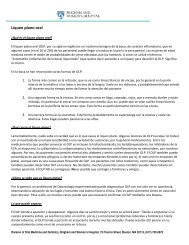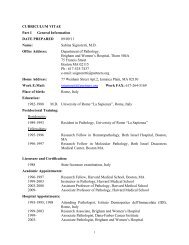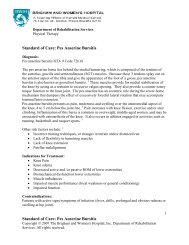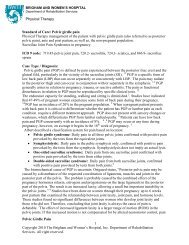Ocular Myasthenia Gravis A Patient's Guide - Brigham and Women's ...
Ocular Myasthenia Gravis A Patient's Guide - Brigham and Women's ...
Ocular Myasthenia Gravis A Patient's Guide - Brigham and Women's ...
Create successful ePaper yourself
Turn your PDF publications into a flip-book with our unique Google optimized e-Paper software.
<strong>Ocular</strong> <strong>Myasthenia</strong> <strong>Gravis</strong><br />
Devin Mackay, MD <strong>and</strong> Sashank Prasad, MD<br />
Division of Neuro-Ophthalmology<br />
<strong>Brigham</strong> <strong>and</strong> Women’s Hospital<br />
Harvard Medical School<br />
www.brigham<strong>and</strong>womens.org/neuro-ophthalmology<br />
A Patient’s <strong>Guide</strong><br />
Symptoms Diagnosis Treatment
Sashank Prasad, MD<br />
Harvard Medical School<br />
<strong>Brigham</strong> <strong>and</strong> Women’s Hospital<br />
Division of Neuro-Ophthalmology<br />
What is myasthenia gravis<br />
<strong>and</strong> what causes it?<br />
<strong>Myasthenia</strong> gravis is a<br />
condition that causes<br />
weakness of specific<br />
muscles in the body.<br />
Normally nerves send a<br />
signal to muscles using a<br />
chemical called acetylcholine,<br />
which tells the<br />
muscles when to move. In<br />
patients with myasthenia<br />
gravis, the body’s immune<br />
system mistakenly<br />
interferes with the<br />
muscles’ receptors for<br />
acetylcholine. When these<br />
receptors cannot work<br />
properly, the affected<br />
muscles tire easily. The<br />
amount of weakness<br />
typically fluctuates <strong>and</strong><br />
may be worse at the end<br />
of the day.<br />
Symptoms<br />
<strong>Myasthenia</strong> gravis<br />
causes weakness in<br />
some muscles.<br />
This condition is<br />
caused by a problem<br />
in the body’s immune<br />
system.<br />
Nerves release a chemical called acetylcholine in order to<br />
signal muscles to move. In patients with myasthenia gravis,<br />
the body’s immune system attacks the receptors for<br />
acetylcholine. As a result, the muscles do not properly<br />
receive a signal from the nerves, <strong>and</strong> they become weak.<br />
(Image courtesy JAMA 2005; 293:1940. Copyright ! 2005 American<br />
Medical Association. All rights reserved.)
Sashank Prasad, MD<br />
Harvard Medical School<br />
How is ocular<br />
myasthenia gravis<br />
different from generalized<br />
myasthenia gravis?<br />
<strong>Ocular</strong> myasthenia<br />
gravis only affects the<br />
muscles that move the<br />
eyes <strong>and</strong> eyelids. The<br />
symptoms of ocular<br />
myasthenia gravis include<br />
double vision<br />
(seeing two images<br />
instead of one), trouble<br />
focusing, <strong>and</strong> drooping<br />
eyelids. On the other<br />
h<strong>and</strong>, generalized myasthenia<br />
gravis affects<br />
muscles throughout the<br />
body. In addition to<br />
visual symptoms,<br />
generalized myasthenia<br />
gravis may cause trouble<br />
speaking, trouble swallowing,<br />
<strong>and</strong> weakness in<br />
the arms or legs.<br />
<strong>Brigham</strong> <strong>and</strong> Women’s Hospital<br />
Division of Neuro-Ophthalmology<br />
Symptoms<br />
ss<br />
The visual symptoms<br />
of myasthenia gravis<br />
include:<br />
• Double vision<br />
• Trouble focusing<br />
• Drooping eyelids<br />
The severity of the<br />
symptoms can<br />
fluctuate <strong>and</strong> be worse<br />
with fatigue
Sashank Prasad, MD<br />
Harvard Medical School<br />
The brain finely<br />
controls the eye muscles<br />
in order to keep the eyes<br />
aligned properly. Weakness<br />
of the eye muscles<br />
leads to misalignment of<br />
the eyes, which causes<br />
the eyes to perceive the<br />
same object in two<br />
<strong>Brigham</strong> <strong>and</strong> Women’s Hospital<br />
Division of Neuro-Ophthalmology<br />
Why does ocular<br />
myasthenia gravis typically<br />
cause double vision?<br />
different locations.<br />
Double vision is a<br />
common symptom of<br />
myasthenia gravis because<br />
this condition very<br />
frequently affects the<br />
strength of the eye<br />
muscles.<br />
Symptoms<br />
Patients with ocular<br />
myasthenia gravis<br />
develop double vision<br />
because weakened eye<br />
muscles cause the<br />
eyes to become<br />
misaligned<br />
Although a minority of<br />
patients with ocular<br />
myasthenia gravis<br />
never develop weakness<br />
in other parts of<br />
the body, most<br />
patients develop<br />
generalized<br />
myasthenia gravis<br />
within a few years<br />
How often does<br />
myasthenia gravis only<br />
affect the eyes?<br />
For about one half of<br />
patients with myasthenia<br />
gravis, the first symptoms<br />
are visual. About 15% of<br />
these patients will remain<br />
only having visual<br />
symptoms, even years<br />
after their diagnosis. In<br />
the other 85% of<br />
patients, however, symptoms<br />
of weakness will<br />
develop in another part of<br />
the body, usually within<br />
the next three years. At<br />
that time, these patients<br />
are considered to have<br />
generalized myasthenia<br />
gravis.
Sashank Prasad, MD<br />
Harvard Medical School<br />
How is ocular myasthenia<br />
gravis diagnosed?<br />
Your doctor will begin<br />
by asking about your<br />
symptoms <strong>and</strong> performing<br />
a physical<br />
examination. It will be<br />
important to carefully<br />
test the eyelids <strong>and</strong> eye<br />
movements, <strong>and</strong> to see<br />
what happens to the<br />
muscles when they are<br />
fatigued <strong>and</strong> when they<br />
have rested.<br />
Your doctor may<br />
request additional tests<br />
to confirm a diagnosis of<br />
myasthenia gravis. A<br />
blood test can check if<br />
the immune system is<br />
blocking the signals that<br />
travel from the nerves to<br />
the muscles. In patients<br />
with ocular myasthenia<br />
gravis (who have visual<br />
symptoms only) this<br />
blood test has lower<br />
accuracy, so a negative<br />
result might require<br />
additional testing.<br />
One important test to<br />
help diagnose myasthenia<br />
gravis is called a nerve<br />
conduction study/electromyogram<br />
(sometimes<br />
called “EMG” for short).<br />
In part of this test, a<br />
small electrical stimulation<br />
is delivered to a<br />
nerve, <strong>and</strong> the responses<br />
are measured from a<br />
muscle. The most<br />
accurate test to diagnose<br />
myasthenia gravis is<br />
called a single fiber<br />
electromyogram<br />
(SFEMG). An SFEMG test<br />
involves very small<br />
needles that can measure<br />
responses from two<br />
nearby muscle fibers.<br />
Both the EMG <strong>and</strong><br />
SFEMG tests can reveal a<br />
pattern of responses that<br />
suggests myasthenia<br />
gravis.<br />
<strong>Brigham</strong> <strong>and</strong> Women’s Hospital<br />
Division of Neuro-Ophthalmology<br />
Diagnosis<br />
To diagnose ocular<br />
myasthenia gravis, a<br />
doctor might:<br />
• Test the eyelids <strong>and</strong><br />
eye movements<br />
• Run a blood test<br />
• Perform special<br />
studies (EMG or<br />
SFEMG) to measure<br />
the electrical<br />
responses in nerves<br />
<strong>and</strong> muscles
Sashank Prasad, MD<br />
Harvard Medical School<br />
Treatment<br />
Treatments for ocular<br />
myasthenia gravis<br />
include:<br />
• Pyridostigmine<br />
(Mestonin) to build<br />
acetylcholine levels<br />
<strong>and</strong> glycopyrrolate<br />
to reduce the side<br />
effects<br />
• Corticosteroids<br />
such as prednisone<br />
to control the<br />
immune response<br />
• If there is a<br />
thymoma (tumor),<br />
removing it may<br />
improve symptoms<br />
One of the medications<br />
that is commonly<br />
used to treat myasthenia<br />
gravis is called pyridostigmine<br />
(Mestinon).<br />
This medication helps<br />
build higher levels of the<br />
chemical acetylcholine,<br />
which is the signal that<br />
tells a muscle to move.<br />
The side effects of<br />
pyridostigmine can include<br />
diarrhea, abdominal<br />
cramps, nausea,<br />
<strong>and</strong> vomiting. Another<br />
medication called glycopyrrolate<br />
can be used to<br />
reduce these effects.<br />
Corticosteroid medications,<br />
such as<br />
prednisone, can also be<br />
used to help patients<br />
with myasthenia gravis.<br />
These medicines can be<br />
very effective at<br />
controlling the immune<br />
response that causes<br />
myasthenia. Unfortunately,<br />
long-term use<br />
of steroids is also<br />
associated with side<br />
effects that include<br />
osteoporosis (weakening<br />
<strong>Brigham</strong> <strong>and</strong> Women’s Hospital<br />
Division of Neuro-Ophthalmology<br />
What are the<br />
treatments for ocular<br />
myasthenia gravis?<br />
~<br />
of bones), diabetes, high<br />
blood pressure, sleep<br />
disturbance, <strong>and</strong> emotional<br />
changes. In some<br />
cases, other medications<br />
can be used to help<br />
control the immune<br />
system <strong>and</strong> lower the<br />
dosage of prednisone.<br />
These medications<br />
include azathioprine<br />
(Imuran), cyclosporine,<br />
<strong>and</strong> mycophenolate<br />
mofetil (Cellcept).<br />
If myasthenia gravis is<br />
diagnosed, a CT scan of<br />
the chest should be<br />
performed in order to<br />
look for a type of benign<br />
tumor called a<br />
thymoma. Many experts<br />
believe that if this tumor<br />
is present, removing it<br />
can improve the<br />
symptoms of myasthenia.<br />
Thymomas are<br />
present more often in<br />
patients with generalized<br />
myasthenia gravis<br />
compared to those with<br />
ocular myasthenia<br />
gravis.
Sashank Prasad, MD<br />
Harvard Medical School<br />
<strong>Brigham</strong> <strong>and</strong> Women’s Hospital<br />
Division of Neuro-Ophthalmology<br />
Pyridostigmine (Mestinon) is a medication that<br />
reverses the symptoms of myasthenia gravis by<br />
boosting acetylcholine levels.<br />
How can double vision<br />
be treated?<br />
Double vision that<br />
results from myasthenia<br />
gravis is most often<br />
treated by blocking the<br />
vision from one eye.<br />
Either an eye patch can<br />
be worn or scotch tape<br />
can be placed over one<br />
lens in the eyeglasses. If<br />
one eyelid is very droopy<br />
<strong>and</strong> blocks the vision in<br />
that eye, the double<br />
vision will not require a<br />
separate treatment.<br />
Usually special glasses<br />
with prisms are not<br />
helpful because of the<br />
considerable fluctuation<br />
in the amount of double<br />
vision caused by<br />
myasthenia gravis.<br />
Treatment<br />
Treatments for double<br />
vision caused by<br />
myasthenia gravis<br />
include:<br />
• Wearing an eye<br />
patch<br />
• Placing scotch<br />
tape over one lens<br />
in the eyeglasses<br />
~
Sashank Prasad, MD<br />
Harvard Medical School<br />
<strong>Brigham</strong> <strong>and</strong> Women’s Hospital<br />
Division of Neuro-Ophthalmology<br />
What medications should<br />
be avoided?<br />
Certain medications<br />
can worsen the symptoms<br />
of myasthenia <strong>and</strong><br />
should be avoided. These<br />
medications include specific<br />
antibiotics (called<br />
aminoglycosides <strong>and</strong><br />
quinolones), betablockers,<br />
calcium channel<br />
blockers, <strong>and</strong><br />
phenytoin (Dilantin). If a<br />
patient with myasthenia<br />
gravis requires a surgical<br />
procedure, the anesthesiologist<br />
should be<br />
aware in order to use the<br />
proper medications.<br />
Treatment<br />
Patients with<br />
myasthenia gravis<br />
should avoid<br />
medications<br />
including:<br />
• Specific<br />
antibiotics<br />
(aminoglycosides<br />
<strong>and</strong> quinolines)<br />
• Beta-blockers<br />
• Calcium channel<br />
blockers<br />
• Phenytoin<br />
(Dilantin)<br />
Where can I get more<br />
information on ocular<br />
myasthenia gravis?<br />
For more information on<br />
ocular myasthenia<br />
gravis, consider the<br />
following sources:<br />
~<br />
<strong>Myasthenia</strong> <strong>Gravis</strong><br />
Foundation of America<br />
http://www.myasthenia.org/<br />
WhatisMG.aspx<br />
National Institutes of Health<br />
http://www.ncbi.nlm.nih.<br />
gov/pubmedhealth/PMH00<br />
01731/<br />
North American Neuro-<br />
Ophthalmology Society<br />
http://www.nanosweb.org/<br />
i4a/pages/index.cfm?pageI<br />
D=3286<br />
! 2011 All Rights Reserved.


